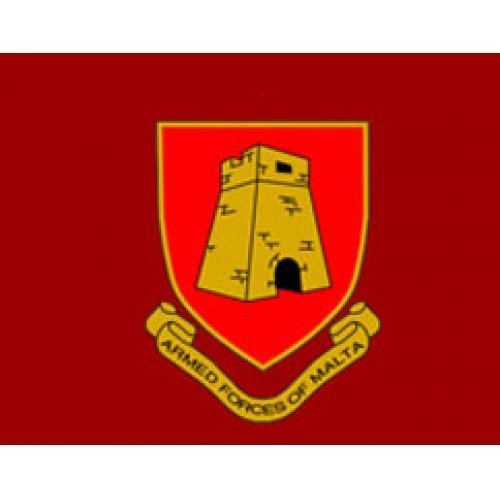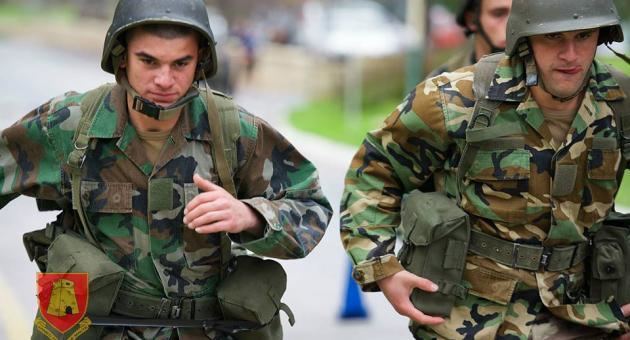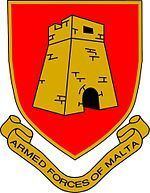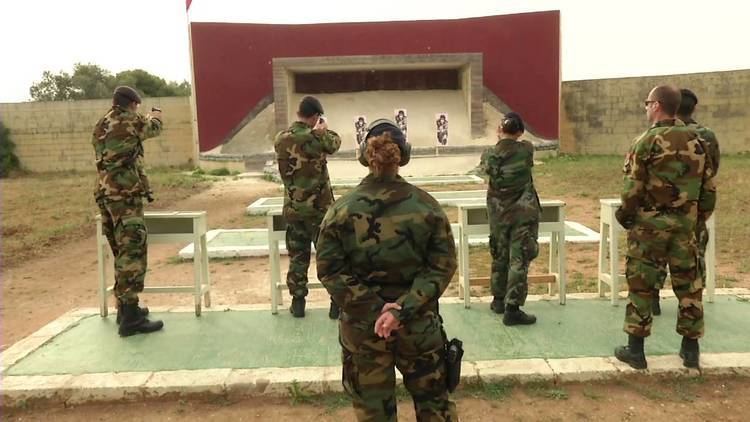Conscription Voluntary Budget 42.7 million EUR (2012) | Military age 18 years of age Founded 19 April 1973 | |
 | ||
Service branches Headquarters1st Regiment3rd Regiment4th RegimentMaritime SquadronAir Wing Chief of Defense Brigadier Jeffrey Curmi Available formilitary service males age 15-49: 99,107 (2002 est.), age 15–49 Commander in chief Marie-Louise Coleiro Preca Similar Military of Moldova, Luxembourg Army, Military of San Marino, Army of the Republic of Macedonia, Lithuanian Armed Forces | ||
Armed forces of malta recruit intakes nos 131
The Armed Forces of Malta is the name given to the combined armed services of Malta. The AFM is a brigade sized organisation consisting of a headquarters and three separate battalions, with minimal air and naval forces. Since Malta is guardian of the European Union's most southerly border, the AFM has an active role in border control.
Contents
- Armed forces of malta recruit intakes nos 131
- The armed forces of malta high profile events
- History
- Headquarters AFM
- 1st Battalion AFM
- 3rd Battalion AFM
- 4th Battalion AFM
- Air Wing
- Maritime Squadron
- Volunteer Reserve Force
- Italian Military Mission Malta
- Ranks of the AFM
- Operations
- Equipment
- Aircraft
- Maritime Patrol Vessels
- Uniform and Personal Equipment
- References

The armed forces of malta high profile events
History
See: King's Own Malta Regiment

In April 1800 after the Siege, Thomas Graham raised the first official Maltese Troops in the British Army, which became known as the Maltese Light infantry. This battalion of men was disbanded in 1802 and succeeded by the Maltese Provincial Battalions, the Malta Coast Artillery and the Maltese Veterans. In 1815, Lieutenant Colonel Count Francis Rivarola was entrusted with the task of raising the Royal Malta Fencible Regiment following the disbandment of the Provincials, Veterans and Coast Artillery. The Royal Malta Fencible Regiment was converted to an artillery regiment in 1861, and became known as the Royal Malta Fencible Artillery. Twenty-eight years later, the worthy predecessors of the Armed Forces of Malta came into existence following the formation of the Royal Malta Artillery on March 23, 1889.

The King's Own Malta Regiment, it was a territorial infantry regiment on the British Army colonial list prior to Malta's independence. It was formed in 1801 as the "Regiment of Maltese Militia", existing only until the following year. It was reformed as the "Maltese Militia" by Sir Adrian Dingli in 1852 before disbanding again in 1857. It was raised again, this time as the "Royal Malta Regiment of Militia" in 1889; this regiment was considered to be the successor to the "Maltese Chasseurs" of the early 19th century. The regiment was renamed the "King's Own Royal Malta Regiment of Militia" in 1903, and was disbanded in 1921. The regiment was raised for a fourth time in 1931 as the "King's Own Malta Regiment". Initially on the British Establishment, in 1951 it was transferred to the Malta Territorial Force before becoming part of the Malta Land Force on Malta's independence in 1970. The regiment was disbanded in 1972.

The AFM was formed upon Malta becoming a republic in 1974, when 1 Regiment Royal Malta Artillery was renamed as 1 Regiment, AFM. This initially continued the artillery role, with 2 Regiment formed as an engineers unit. In 1980, 1 Regiment became a mixed unit, with infantry, aircraft and maritime responsibilities, the artillery element being transferred to 2 Regiment. In 1992, there was a major re-organisation, which led to the formation of 3 Regiment and the current structure.
KOMR Battle Honours
Headquarters, AFM

HQ AFM is the main command centre for the Armed Forces of Malta, and is divided into four main areas.
1st Battalion, AFM
1st Battalion is Malta's infantry unit, and has primary responsibility for the territorial defence of the country. It is divided into three rifle companies, a support company and a headquarters company.
3rd Battalion, AFM
3 Battalion is the AFM's main support unit, and consists of three operational sections.
4th Battalion, AFM
Established with the AFM review of Oct 30th, 2006, it includes:
Air Wing
The Air Wing of the Armed Forces of Malta is the aerial component of the current Maltese military. The Air Wing has responsibility for the security of Maltese airspace, conducts maritime patrol and search and rescue duties, and provides military assistance to other government departments of Malta. With air wing of armed forces of Malta being based at Malta International Airport
Maritime Squadron
The Maritime Squadron of the Armed Forces of Malta is the naval component of the current Maltese military. The Maritime Squadron has responsibility for the security of Maltese territorial waters, maritime surveillance and law enforcement, as well as search and rescue. It is based at Hay Wharf (Xatt it-Tiben) in Floriana. It currently operates 10 patrol vessels and 6 other boats.
Volunteer Reserve Force
In addition to the regular forces, there is also the Volunteer Reserve Force, which consists of part-time volunteers to support the regulars at Air Defence & Support Company (ADSC), 1 Regiment AFM.
Italian Military Mission Malta
The presence of the Italian Military Mission (IMM) in Malta has taken form in the shape of technical assistance spread over three periods of time. Firstly, between 1973 and 1979, then between 1981 and July 1988, and lastly between July 1988 to date.
IMM personnel resources in Malta total to 12 Officers and 35 NCOs from the three Service branches of the Italian Armed Forces. It is also equipped with two AB 212 helicopters, 15 heavy plant vehicles, 60 light all-purpose utility vehicles, radio telecommunications, and weapons.
Ranks of the AFM
Enlisted Rank - Gunner, Lance Bombardier, Bombardier, Sergeant, Staff Sergeant
Warrant Officer Rank - Warrant Officer Class 2, Warrant Officer Class 1
Officer Rank - Second Lieutenant, Lieutenant, Captain, Major, Lieutenant Colonel, Colonel, Brigadier
Operations
Since Malta's entry in the European Union, the AFM has become more engaged in Peace keeping missions. The AFM has participated in 7 overseas operations.
Equipment
On land, 1 Regiment is the designated home of the Maltese Infantry with C (Special Duties) Company being at the cutting edge of this unit. The company is being trained and equipped to be able to contribute a platoon for overseas humanitarian and rescue missions attached to an Italian regiment on missions mandated by the UN or the OSCE. Malta has to ensure that the troops are adequately trained and equipped up to Italian army standards for seamless integration within an Italian regiment, able to tackle any foreseeable problems for up to a year. C (Special Duties) Company is also being geared for a quick reaction role, ready for action at a moment’s notice should an emergency, such as terrorism, arise
The kit used by the Maltese foot soldier has changed drastically in recent years. The fiat for change was given to C Company prior to its successful participation in the multi-national Partnership for Peace exercise in 1996. Following Malta’s pledge towards the EU’s Military Headline Goal in 2000, procurement received another boost.
With funding being a perennial problem, over the years the Force had to rely on varied equipment transferred or financed by several countries. Standardisation was a headache. But matters have improved considerably, especially with regard to light infantry weapons. At one time there were as many as eight different types of pistol and associated ammunition, now there are two, principally the Beretta FS and some Makarov. The army has also bought Heckler and Koch sub-machine guns and, thanks to Chinese assistance, all infantrymen now have their own individual AKM rifle.
The Maltese Infantry soldier is equipped with the latest British Army issue Personal Load Bearing Equipment including both the webbing and bergen as well as the woodland pattern battle dress uniform, Avon S10 respirator and Kevlar ballistic helmet. Protective ballistic vests and night vision goggles are carried when required.
Infantry soldiers have a number of weapons at their disposal including the Kalashnikov AK-47 and AKM rifles, the Heckler and Koch MP 5 sub-machine guns, the Beretta 92 FS pistols, the PKM machine gun, as well as the General Purpose Machine Gun L7A1. Sniper teams are equipped with the Accuracy International Sniper rifle while the anti-tank troops embedded within the infantry platoons carry the RPG-7 rocket launcher.
Eight-man sections are deployed either on Landrovers or Iveco VM-90 trucks.The AFM also operates a number of Bedford trucks which, despite their age, still give excellent service. Suffice to say that these trucks were driven in convoys all the way to Kosovo and back three times in 2001 and not one of them broke down. The Explosives Ordnance Disposal Unit is equipped with two remote controlled Explosive Ordnance Disposal Vehicles – robots used to disable a bomb from a safe distance. The first was bought in 1989 and a second, much more sophisticated one, was bought last year.
The Air Defence Battery forms part of 2nd Regiment and operates Bofors 40L/70 anti-aircraft guns and four barrelled ZSU-4 heavy machine guns. The Bofors guns can be operated either manually or electrically and they can be laid on their targets either visually or through radar. The 14.5mm machine guns can only be operated manually but they provide a high rate of fire. Air defence posed particular problems because of the passage of time on the Bofors guns, built in the early 1950s.
Aircraft
See: AFM aircraft
Maritime Patrol Vessels
See: AFM maritime patrol vessels
Uniform and Personal Equipment
The AFM wears a single cap badge, based on that of the Royal Malta Artillery, which consists of a gun, similar to that worn by the Royal Artillery but without the crown, on top of a Maltese Cross, with the motto "Tutela Bellicæ Virtutis" underneath.
